Abstract
Raw earth is a construction material unknown to most people. Nowadays, raw-earth constructions are an area of growing interest, both for rescuing the heritage and for a rediscovered environmentally friendly building and eco-sustainability material. However, because raw-earth constructions are a forgotten technique, we find problems of a lack of skilled people at all levels in this area, from designers to masons, as well as problems of how to carry out compatible conservation works on earthen heritage. This paper tries to fill the gap for a peculiar historic earthen building technology, namely cob (or bauge), which is present in Macerata in the center of Italy. Results are presented on regaining possession of the material and constructional aspects and their initial structural resources, and guidelines are given on how to improve the manufacturing process to reuse the cob technique for construction and for how to accurately work on it for a compatible and sustainable conservation.
1. Introduction
As has been happening in other countries for several years [1,2,3,4,5,6,7,8,9,10], in Italy too, there is now a renewed interest in raw-earth constructions (see for example: the Italian bill dated 14/02/2002 titled “Normative to support raw-earth buildings and raw-earth as a building material”). Raw-earth constructions are, in fact, environmentally-friendly and highly bio-sustainable. Their very low environmental impact is thanks to the little energy needed during the building stage and the thorough recyclability of almost all of their building materials, which are often completely natural and compatible [5]. In addition, raw-earth constructions perform well thermally [11,12,13,14,15,16,17]; allowing the buildings good thermal insulation capacities and thermo-hygrometric comfort of the indoor environments, including sound insulation [18]. In this way, raw-earth constructions have been encouraged during recent years, especially in those countries where they could be an easily accessible and economically attractive resource due to the climatic and economic conditions, , joining well to the local traditional architecture.
Moreover, thanks to the diffusion of a new receptivity, the old historical earthen architectures begin to be no longer seen as poor constructions inherited from the past or as obstacles and menaces to new settlements and productive investments, but this cultural heritage is perceived as being the face of a local identity and as a possible way of development. This new sensibility—embraced also by designers and Cultural Heritage offices—is spreading towards a working philosophy that considers architectural assets not only for historic-artistic value but also a testimony of an antique art of building that must be understood and not refused, so the concept of conservation should also be extended to building techniques. Nevertheless, at least in Italy, the prejudice with which these buildings were often regarded has resulted in a completely negative attitude to their restoration and reuse up until now. Thus, today only a small amount of these buildings are left, because of the gradual abandonment of the remains and the consequent reuse of their recyclable parts. As a result, the remaining examples must be urgently safeguarded and compatible uses must be sought to promote their regular maintenance. Raw-earth architectures are, in fact, particularly subject to natural degradation (especially by weathering, since there are frequently no protective elements such as gutters, and in some cases whole roof sections have collapsed due to neglect) and they have been estimated to have a life of some 60 years without maintenance [19]. In response to the initial stimulus of regional funds and laws (see for example: Marche Regional Law no. 6 of 24/03/1998), some Italian regions, like the Marche region, have started to develop a policy for restoring earth buildings (see for example: Marche Rural Development Plan 2000/06), promoting their protection and conservation, and their organization into buildings suitable for new use.
However, one must face the problem that it is usually unknown how to make repairs and reuse the building technique at an affordable cost. To a certain extent, this is caused by the lack of skilled masons and because engineers and architects are used to ignore earth as a building material. Thus, designers are not able to understand how an earthen building works, and such difficulties can often lead to wrong planning decisions. It is easy to find incorrect repairs, such as the typical cement-rich renders covering raw-earth walls [5]. These renders are too stiff to adapt to natural wall movements, so they easily crack, allowing rain water to enter and to become trapped inside the wall due to the low porosity of the rendering. The use of earth- or lime-based renders would be more appropriate. Moreover, there is a strong need to assess earthen building mechanical properties in order to guarantee an adequate structural safety, especially for some local earthen building techniques such as cob, that has been studied less than, for example, adobe.
To this end, the following paragraphs report the first results of a research that has dealt with an Italian traditional cob technique used for the construction of historical earthen buildings present in Macerata (Italy), just to regain possession of the material and constructional aspects, namely the so-called workmanlike [20], and their initial structural resources, in order to give guidelines to improve the technology for its reuse in new earthen constructions or to accurately work on these historical earthen buildings for their compatible and sustainable conservation.
The Case Study: Historical Cob Constructions in Macerata
The historical cob earthen buildings in Macerata are the starting point of this research. A full quarter, called “Villa Ficana”, near the northern neighborhood of Macerata, was built during the 19th century not far away from the city center and had earthen walls in many of its houses. This is one of few examples of a whole intact raw earth workers’ village which has remained with us up until now.
The Ministry for the Cultural Heritage recently declared this earthen quarter deserving of protection pursuant to the Legislative Decree no. 490/99, considering the absolutely exceptional nature of the area. This guarantees the full conservation of every element of it, recognizing the compound, composed by various buildings, roads, open spaces, gardens, to be of particular historical and documentary importance, insofar as it is material evidence of:
- a pre-urban peasant culture typical of the 19th century;
- an ancient construction technique, capable of creating buildings with natural materials not derived from production processes outside the building site itself, that has by now completely disappeared;
- an urban layout that is unique in its type and as a whole.
In any case, almost all the houses have been abandoned by their owners and have been particularly subjected to weathering since there are often no protective elements such as guttering left (Figure 1). There are many reasons why these houses were abandoned, but most commonly this is because the idea of poverty and marginalization has always been associated with this type of housing in this geographical area.
The common typology of these houses is two floors with a generally external masonry stair (Figure 2). The floor system is composed of a series of timber beams and joists covered with a layer of tile elements. The roof, covered by tile elements, is sloped, usually with the presence of a primary and secondary timber beams. The eaves have a length up to 0.40–0.50 m to protect the walls from rain.
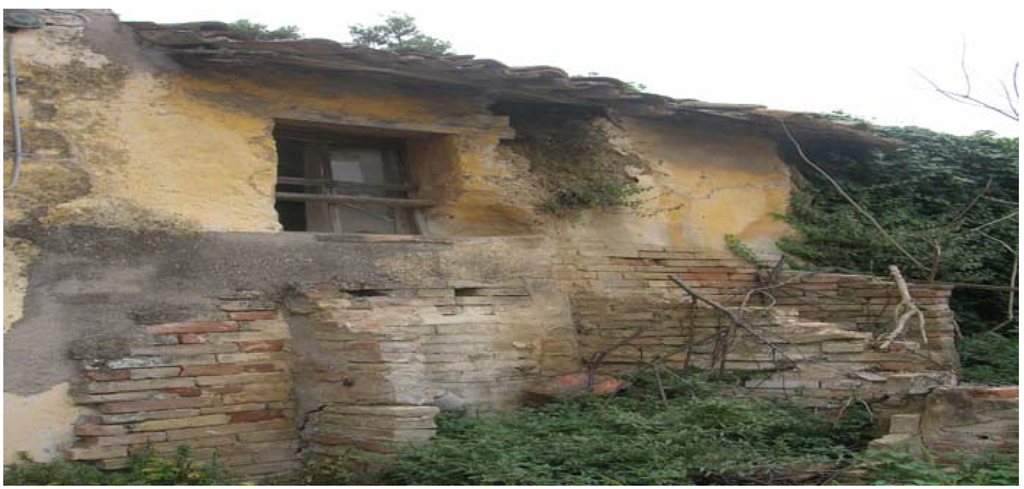
Figure 1.
An example of a neglected raw-earth cob building in Macerata (Italy). The erosion by weathering due to the lack of the roof protection can be seen.
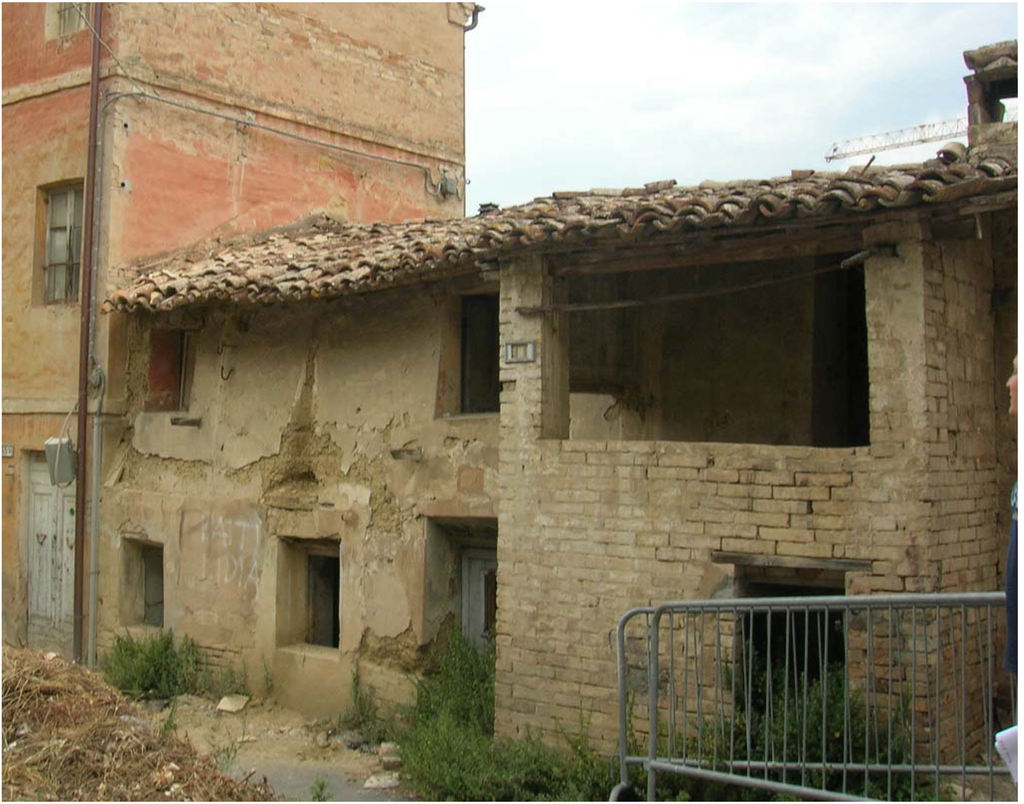
Figure 2.
Typical raw-earth cob architecture at “Villa Ficana” in Macerata (Italy). An external masonry staircase is often present to connect the two levels of the house. A masonry support is also visible low on the left.
The thickness of the earthen walls is about 1–1.10 m on the ground floor and from 0.60 to 1.10 m on the first floor, and the windows are small in order to reduce heat dispersion and water infiltration. In some houses there are also walls made by fired bricks. Several earthen walls were built above a masonry base which has a height of about 0.40–0.50 m. This allowed the wall to resist excessive vulnerability with respect to ground surface erosion and water absorption. Earthen wall external surfaces are sometimes safeguarded by a 0.05–0.10 m earthen plaster or a common vertical brick layer (Figure 3).
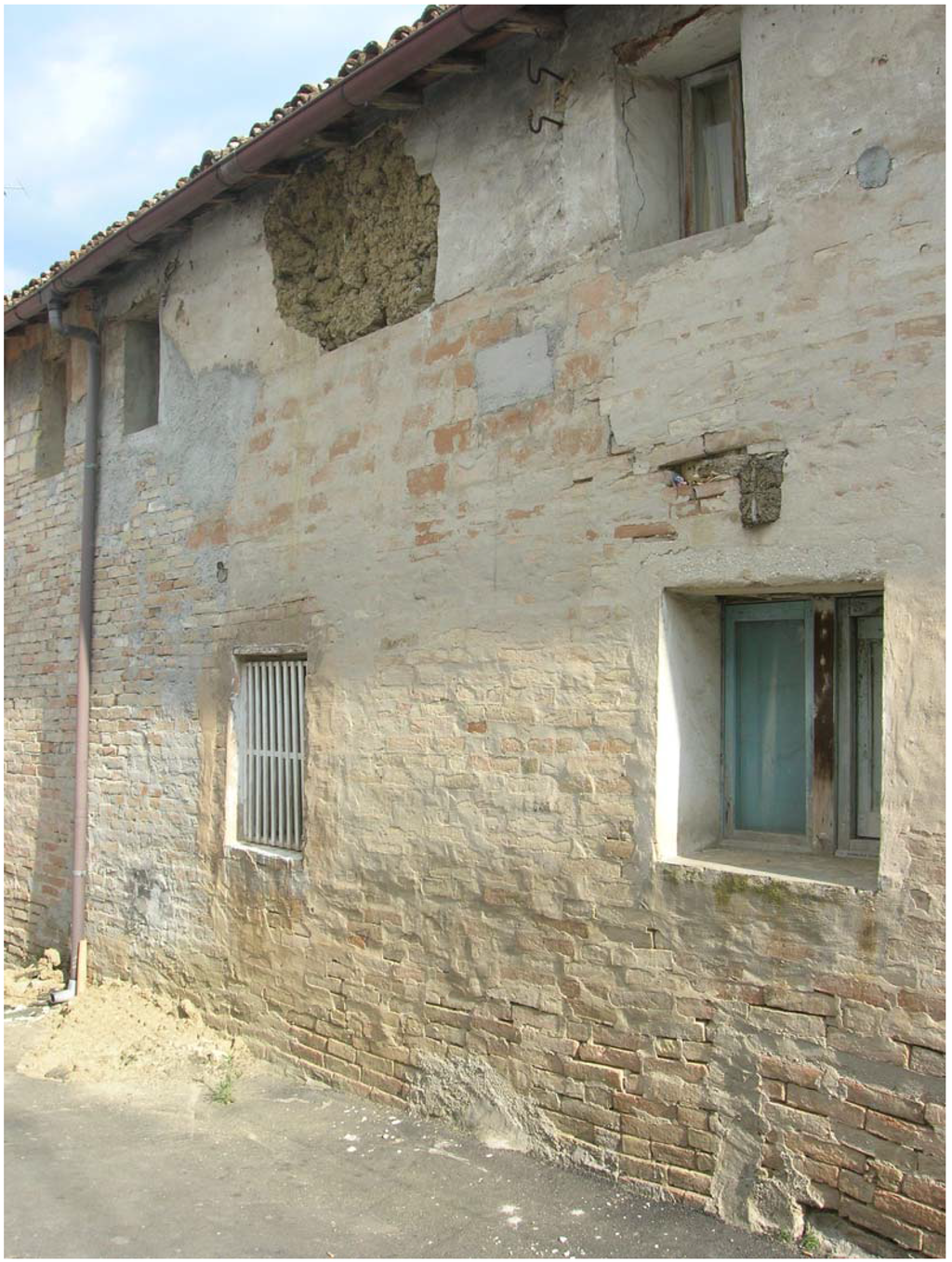
Figure 3.
Raw-earth cob walls are often safeguarded by a thick earthen plaster or by a layer of fired bricks.
Processing the acquired data during accurate surveys and subsequently by laboratory analysis carried out on these earth buildings, it was possible to identify—as first results—the technique used to construct the earthen walls. The technique is similar to the one commonly called “bauge” in France or “cob” in the United Kingdom. Large cylinder-shaped “bricks” (cob bricks) can be in fact easily recognized (Figure 4). They are more or less compressed due to the construction of the wall which bears its own weight. Each base element, or cob brick, is called “massone” in jargon by local inhabitants.
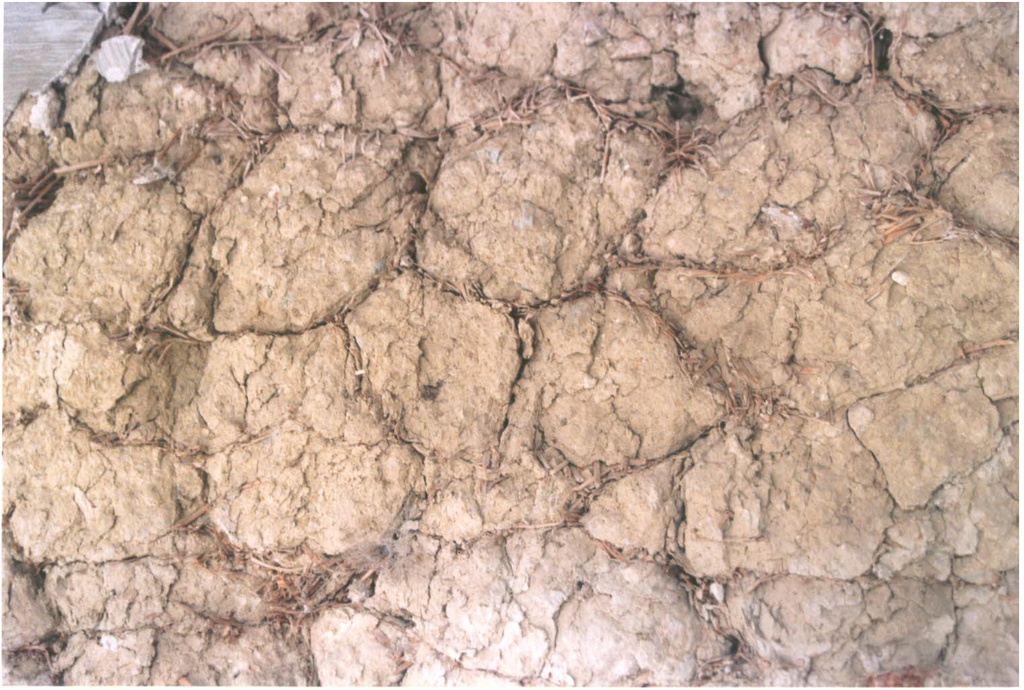
Figure 4.
An external wall reveals the presence of cob bricks covered by straw.
Comparing results from soil composition and limits of consistency (Atterberg’s limits) of earth samples taken from the buildings, the soil used as a construction material directly came from the construction site, as expected. It is clearly not topsoil, which is unsuitable due mainly to the significant amount of organic matter present that biodegrades, absorbs water, and is highly compressible. It has the texture [21], and the limits of consistency [22] reported in Table 1. As a building material, its water content ranged from 6 to 10%, with a dry specific density equal to 1,860 kg/m3. No straw was found in the core of the taken samples, but was only on the external surface, probably to limit the considerable shrinkage of the material [4]. Straw, in fact, can reduce hygrometric shrinkage because of both its tensile strength and, above all, its slow water release capability [3].
The onsite soil was probably moistened and trod on by human feet in shallow pits. Subsequently, it was shaped into large cylinders (cob bricks) of 0.08 to 0.15 m in diameter to a depth of 0.30–0.40 m, which were rolled and covered by straw. These were then thrown up to a bricklayer who stood on a finished part of the wall under construction and formed the new layer of cob by throwing the still moist cylinders forcefully and rhythmically onto the wall up to a height of about 0.50–0.70 m. The wall under construction was then left to dry for some days, then the successive level could be constructed. In this way, very thick walls (0.60 to 1.10 m) consisting of several layers of monolithic appearance could be built.
2. Materials and Methods
Experimental tests were performed. They were firstly aimed at the possibility of reproducing the old technique, using first the onsite soil and then an earth of analogous composition, in order to regain possession of the constructional aspects, namely the so-called workmanship, to characterize a suitable soil for possible restoring intervention, and to improve, if possible, the same technique in the light of our modern technology.
Then, seven cob walls were built to test by compression. Compressive strength is, in fact, the most important parameter for earthen materials, just like for any unreinforced masonry. It enables not only the quality control of a material, but especially represents a means to assess and compare the material’s performance [1]. In this case, the aim was to evaluate the initial compressive strength; that is the compressive strength when the first elevation of a cob earthen wall is completed, when cob bricks are still moist and the seasoning not finished. This can allow one to assess how re-using this building technique—both for new constructions, and possibly for restoring intervention or new additions—optimizes time and costs.
Five samples were also tested by shear. The shear strength is, in fact, an important parameter when two materials are coupled and their relative movements are driven by friction and/or cohesion. Even in this case, we aimed at assessing the initial shear strength, which is the shear strength that could exist along the interface between the dried existing earthen cob walls and the newly added, moist cob bricks. This can allow evaluation of possible restoring intervention such as for repairing a crack or super-elevating an existing cob earthen wall.
2.1. Manufacturing Process for Hand-Made Cob Bricks
Initially, the onsite soil was used to produce each earthen base element (cob brick or “massone” in Italian jargon). This enabled the authors to reproduce and to regain possession of the ancient building technique.
Starting from a water content of the onsite soil of about 6%, it was decided to add molding water so to exceed the plastic limit of about 5–10% in order to have a workable mixture, but not to add too much water such that it would be a negative parameter for compressive strength [4]. Thus, an average mass of 3 kg of soil and of 0.6 kg of water mixed together were needed to produce a single cob brick of 0.08–0.10 m in diameter and a length of about 0.35 m. Straw was added by rolling and pushing each sample on a straw-bed. It was cut in fibers with a length of about 50–100 mm and it was wetted before being used, so that it would not absorb water from the earthen samples. An average weight of 0.2 N of straw usually remained on the external surface of each sample.
It took about 4–5 minutes to hand-make a single cob brick.
An average water content of about 28% was found for each cob brick at the end. This is in total agreement with other previous studies [1]. Figure 5 reports a typical drying curve for a cob brick at a constant temperature (T) of 30 ºC and a maximum relative humidity (RH) of 30%. It is worth noting that after about a day, each cob brick reached, on average, a water content lower than its plastic limit, and after about a week its water content was similar to those found on the earthen walls in situ. No samples cracked during the drying process.

Figure 5.
Typical drying curve for a cob brick at a temperature (T) = 30 ºC and maximum relative humidity (RH) ≈ 30%. % water content is shown over time.
Due to its urbanization, it was impossible to use soil coming from Villa Ficana to make a large number of cob bricks. Thus, it was decided to find a compatible soil near Villa Ficana, both for the experimental characterization of the building technique and for possible future restoring works and new constructions. Places close to Macerata were considered in order to more easily detect a soil similar to the in situ one and to reduce transportation costs if used for future restoration interventions.
A soil used to produce fired bricks about 8 km from Villa Ficana was chosen. It came from a local quarry and it was very similar to that used for the Villa Ficana earthen walls. It was called “yellow soil” because of its color, in order to distinguish it from the original one. Table 1 compares their composition and Atterberg’s limits.
The same procedure as described above was performed to hand-make some cob bricks in order to assess the workability of the yellow soil. The only difference was in the initial soil water content, which was about 4.75% for the yellow soil, thus it was necessary to add more molding water (8 N).
No differences were found during the manufacturing process.

Table 1.
Average composition of the two soil analyzed and their liquid limits and plastic indices.
| Clay (%) | Sand (%) | Silt (%) | Liquid limit (%) | Plastic index (%) | |
|---|---|---|---|---|---|
| Original soil | 34 | 17 | 49 | 38 | 19 |
| Yellow soil | 36 | 13.5 | 50.5 | 42 | 21 |
2.2. Mechanical Manufacturing Procedures and Assembly of Cob Walls
To accelerate the production of the base elements and to reduce costs for future possible restoring interventions and new constructions, it was decided to change the soil-water mixture manufacturing procedure to instead use a mechanical mixing machine, commonly used in the manufacturing of fired clay bricks. The mechanical mixing machine blended the selected yellow soil with molding water until reaching an average water content of 35%, in good agreement with previous studies [1]. Each cob brick, instead, continued to be shaped by hand, thanks to a skilled mason, into large cylinders 0.08 to 0.15 m in diameter and 0.30–0.40 m in depth, which were subsequently covered by straw, as before.
No significant differences were found when comparing the completely hand-made cob bricks and the partially mechanically-made cob bricks. It took significantly less time to manufacture each partially mechanically-made cob brick (about 2 minutes).
In this way, about 210 cob bricks were manufactured (Figure 6) and seven earthen walls were made.
Each earthen wall was made by throwing each moistened cob brick forcefully layer upon layer, up to five layers. Each layer was manufactured by six cob bricks, for a total of 30 cob bricks for each earthen wall. Each cob brick was placed immediately adjacent to another with the longest side (about 0.35 m) along the wall thickness, creating staggered joints between each layer (as in the original case). No layer of mortar was included. The nominal dimensions of each wall were 0.60 × 0.35 × 0.30 m3 (Figure 7). Each wall was then left to dry for about a month and a half, which is about the time spent to build a single-storey cob earthen wall, at an average T = 24–26 ºC and an average RH = 63–66% for approximately the first half, and an average RH = 47% for the rest, in order to abruptly simulate a spring or an early autumn season when earthen cob houses were usually built.
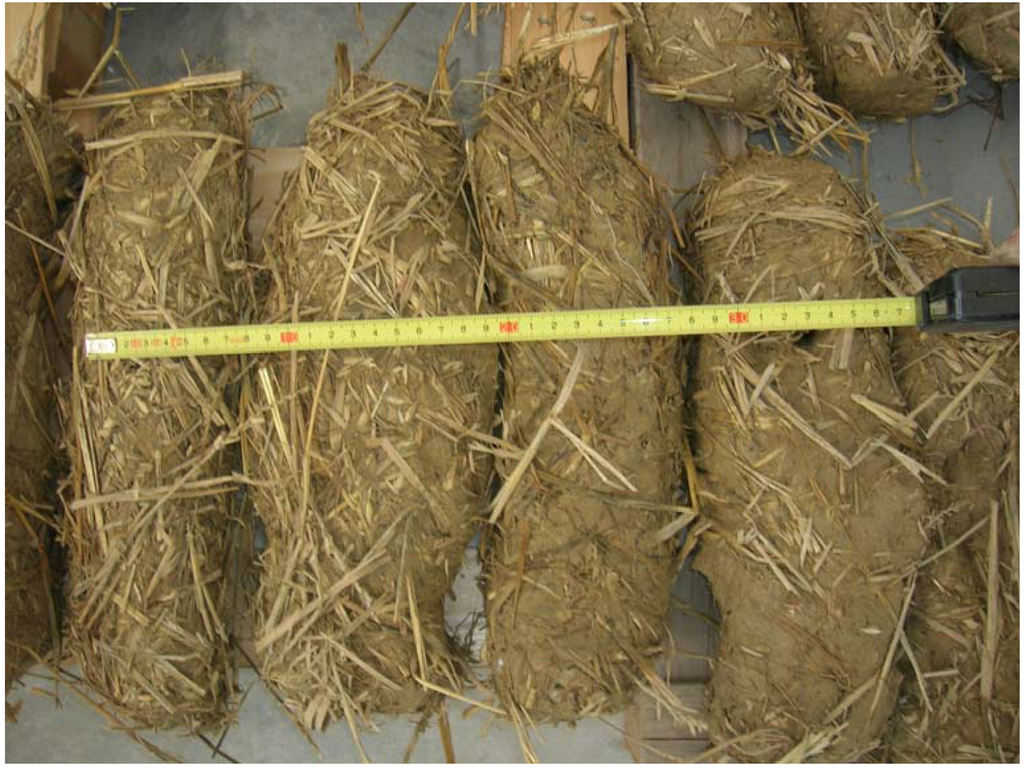
Figure 6.
Some cob bricks made by yellow soil.
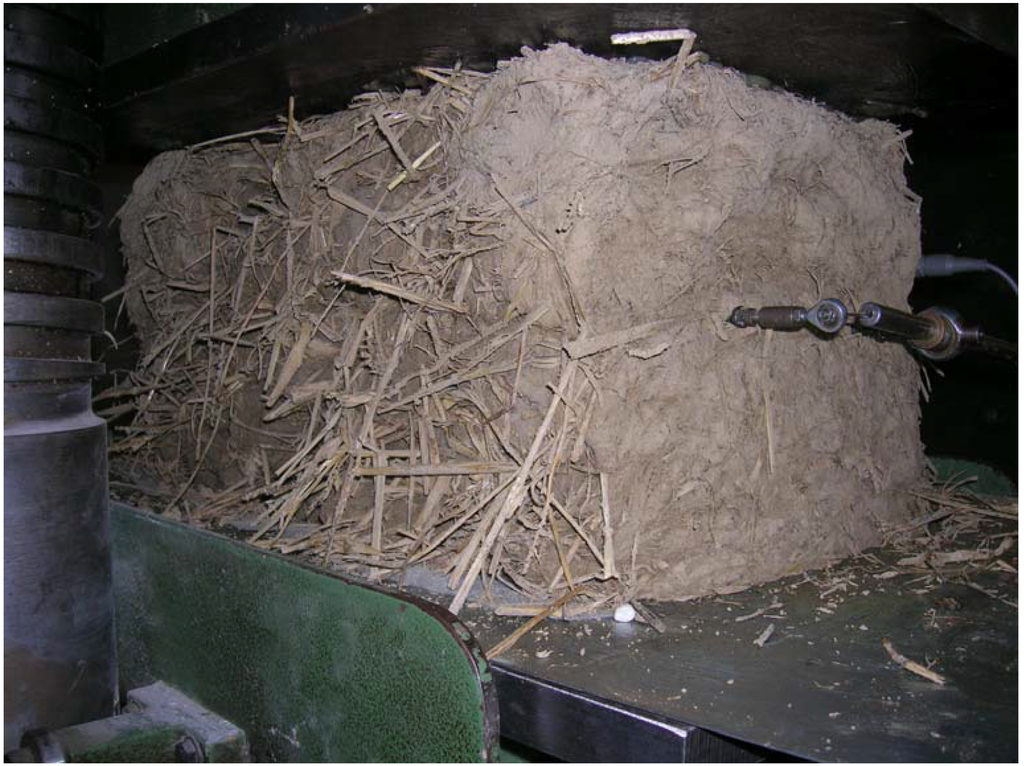
Figure 7.
A raw-earth cob sample tested by uniaxial compression.
2.3. Compression Testing Procedure
Compression tests were set to allow uniform distribution of stresses on specimens. For this purpose, each specimen was inserted between a lower and an upper steel plate sprinkled by fat in order to reduce friction. All the samples were tested along the direction they generally withstood loads. The apparatus used for the compression tests was a first class “Metrocom MI 300” with a 1% error and with an end scale of 3,000 kN. It had two transducers: one for pressure and one for vertical displacement.
The results of the first cob wall tested (specimen 1) was only considered to check the trial, thus they are not reported in the following. In any case, they suggested that a pre-load of 5–10 kN (≈ 3−5.5 × 10−2 MPa) should be applied to each wall to assess the intrinsic behavior of the material and to minimize the measure of the contact adjustment phase related to the fact that the surface sample is not perfectly plane, due to the asperities of the wall surfaces always present and due also to the shrinkage that occurs during the drying process, which is not perfectly uniform [1].
Three samples were also unloaded and then reloaded, when they reached a strain εunld with 1.10εσmax ≤ εunld ≤ 1.15εσmax (wall 5) and 1.25εσmax ≤ εunld ≤ 1.30εσmax (wall 2 and 6), where εσmax is the strain related to the maximum compression stress.
Compression stresses were obtained by dividing the net force by the area of the specimen (i.e., by considering the average or nominal stress), while the initial compressive strength was calculated as the average of the first cycle maximum compression stress of each specimen.
At the end of each compression test, two specimens were sampled: one on the external surface of the wall and another one in the core. These specimens were used for the determination of the external and internal water content of each wall, respectively.
2.4. Shear Testing Procedure
Five specimens were tested under shear. A classical Casagrande apparatus was used [23], thus each specimen was made by yellow soil with an initial water content similar to that of the previous cob bricks and had the following dimensions: 0.06 × 0.06 × 0.22 m3.
No straw was added because of the small specimen dimensions.
Three specimens were tested by shear after seasoning with a water content of about 4−6%, as for the onsite earthen walls, at three different constant compression stresses. They were called DD-samples.
Two of these three samples were tested by shear again at different constant compression stresses, by substituting the “yellow soil” enclosed into the upper part of the Casagrande box with yellow soil at a greater water content (≈33%). In this way, these two samples were both made by two different portions of the same soil but at different water contents. They were called WD-samples.
Table 2 reports the test conditions for each sample. The applied horizontal displacement rate was set to 1.46 × 10−3 mm/min. The shear phase started after 24 hours since the constant compression value had been applied.
The tangential tensions τ were obtained by dividing the net force by the area of the specimen (i.e., by considering the average or nominal stress), while the initial shear strength was assumed as the maximum shear stress of each sample.

Table 2.
The vertical compression stresses applied on each sample during the shear test.
| Vertical compression stress [kPa] | |
|---|---|
| DD-sample 1 | 50 |
| DD-sample 2 | 100 |
| DD-sample 3 | 150 |
| WD-sample 1 | 50 |
| WD-sample 2 | 150 |
2.5. The Assessment of the Building Cost
In order to estimate the cob masonry unitary price per m3 we considered the unitary cost of various production factors and their quantity. In general, we defined the unitary price of a phase as the sum of the following terms:
- cost of materials (earth, coarse sand, straw fibers);
- cost of upload, transport and download of materials;
- cost of the manpower;
- cost of eventual technical equipment;
- general costs for the initial preparation of the building area, which was considered equal to 10% of the sum of materials and manpower costs;
- establishment profit, which was considered equal to 15% of the sum of the costs of materials, manpower and of the general costs.
To estimate the quantity of materials used to realize a single cob brick, the time of the manufacturing process and the others production factors employed in the construction of the cob masonries, we used what was inferred by the experimental campaign (partially mechanically-made cob bricks), and the list of unitary prices with reference to our local market for the building production factors.
3. Results and Discussion
3.1. Compression Test
Stress-strain diagrams for the tested specimens are reported in Figure 8. The maximum compression stress (σmax) and its related strain (εσmax), amd the internal (ωint) and external water content (ωext) for each tested wall are reported in Table 3. The internal water content was still high after one and a half months, while the external water content was a bit greater than that found on the original earthen walls. This is quite reasonable. In fact, as the cob bricks were still moist when used for making an earthen wall, the whole fresh earthen wall took time to dry, depending on the weather conditions and on the free evaporative area for each cob brick, which was reduced to the only external one. In this way, in order to reuse this building technique once again, it is important to assess the initial compressive strength, which will be surely lower than that after drying [4].
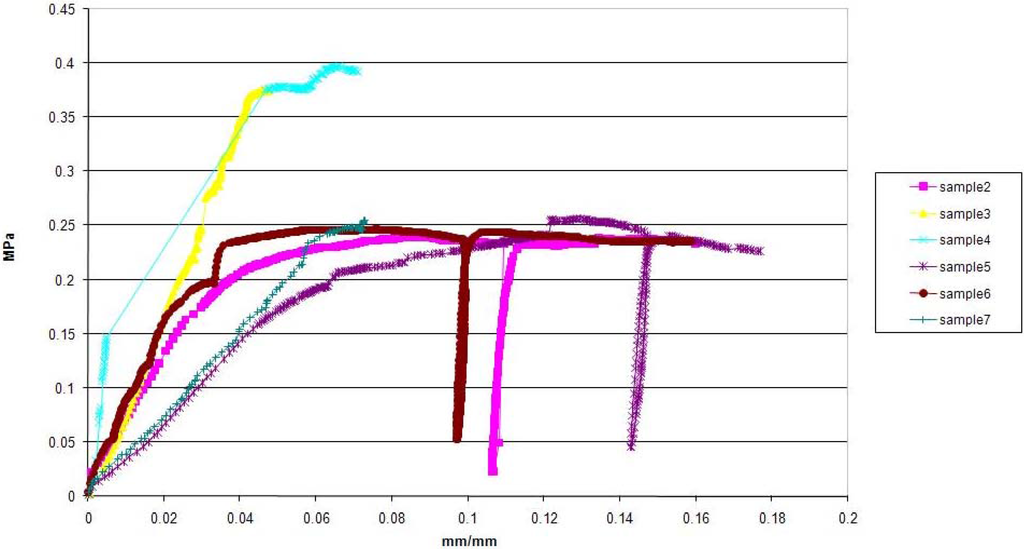
Figure 8.
Compressive stress-strain relationship for all the tested samples. Samples 2, 5 and 6 were also unloaded after they had reached their σmax.

Table 3.
The maximum compression stress (σmax) and its related strain (εσmax), and the internal (ωint) and external water content (ωext) for each tested wall.
| σmax [N/mm2] | εσmax | ωint | ωext | |
|---|---|---|---|---|
| sample 2 | 0.24 | 0.08 | 20.0% | 7.0% |
| sample 3 | 0.37 | 0.05 | 18.0% | 6.5% |
| sample 4 | 0.40 | 0.06 | 16.5% | 8.0% |
| sample 5 | 0.26 | 0.13 | 24.0% | 11.0% |
| sample 6 | 0.25 | 0.08 | 20.0% | 8.0% |
| sample 7 | 0.26 | 0.07 | 19.0% | 10.0% |
From Table 3, the initial compressive strength from all samples is 0.30 MPa. It is immediately possible to note that two walls show a higher maximum compression stress than the others. This can surely be explained by looking at Figure 9, where ωint is related to σmax. An ωint ≈ 19% seems to be a low limit below which compression strength rapidly increases. Thus, if we take apart wall 3 and 4, the initial compressive strength is 0.25 MPa. Instead, for wall 3 and 4 the initial compressive strength is 0.39 MPa, which is more than 50% the previous initial compressive strength. All these values are clearly much lower than those expected for common unstabilized raw-earth constructions (about 2 MPa), even if there are not so many and such detailed data for raw-earth cob constructions [24].
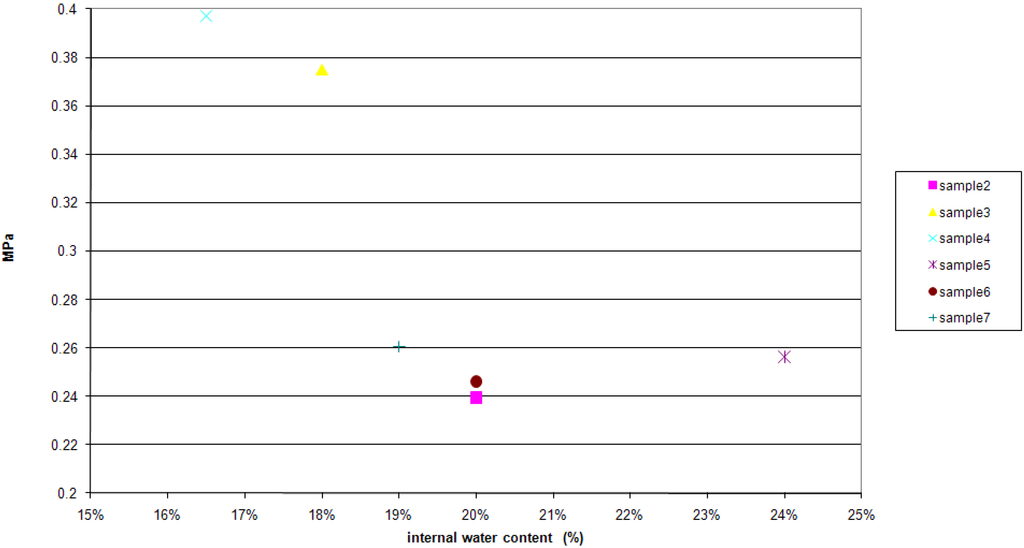
Figure 9.
The dependence of the compressive strength on internal water content for each tested wall.
However, as a single-storey earthen dwelling has usually a stress of about 0.1 MPa [24], the moistened cob wall can surely withstand it remaining within its linear elastic limit, with a reasonable initial safety factor of 2.5, even if we consider the worst initial compression strength. This safety factor is surely going to increase during the subsequent seasoning, allowing a second storey to be built. Large strain will be absorbed during the wall construction from the pre-compression due to self loading.
Looking at Figure 8, from the loaded and unloaded specimens it emerges that there is no significant differences in terms of when they reach their “plastic” plateau before and after the unload cycle. Moreover, when unloaded and then reloaded, all the three samples seem to show a rigid-plastic behavior. This confirms the old rule of art about the importance of forcefully pre-compressing each cob brick added on, layer after layer, when an earthen wall is built, so as to reduce deformations.
3.2. Shear Test
Figure 10 and Figure 11 show the relationships between applied shear stress and its related displacements for DD-samples and WD-samples at different constant compression stresses.
For DD-samples, the contact adjustment phase corresponded to the start of loading (≈ 1 mm). This lag probably depended on the non-perfect contact of the soil specimens with the internal metal faces of the Casagrande box due to its shrinkage by seasoning. Anyway, after this phase, the shear strength reached sharp peaks that seemed to be not influenced too much by friction (that is, cohesion played the most important role), reaching high values between 0.3−0.5 MPa; values that are similar to those found for common unstabilized raw-earth constructions (about 0.5 MPa) even if not explicitly for cob constructions [24].
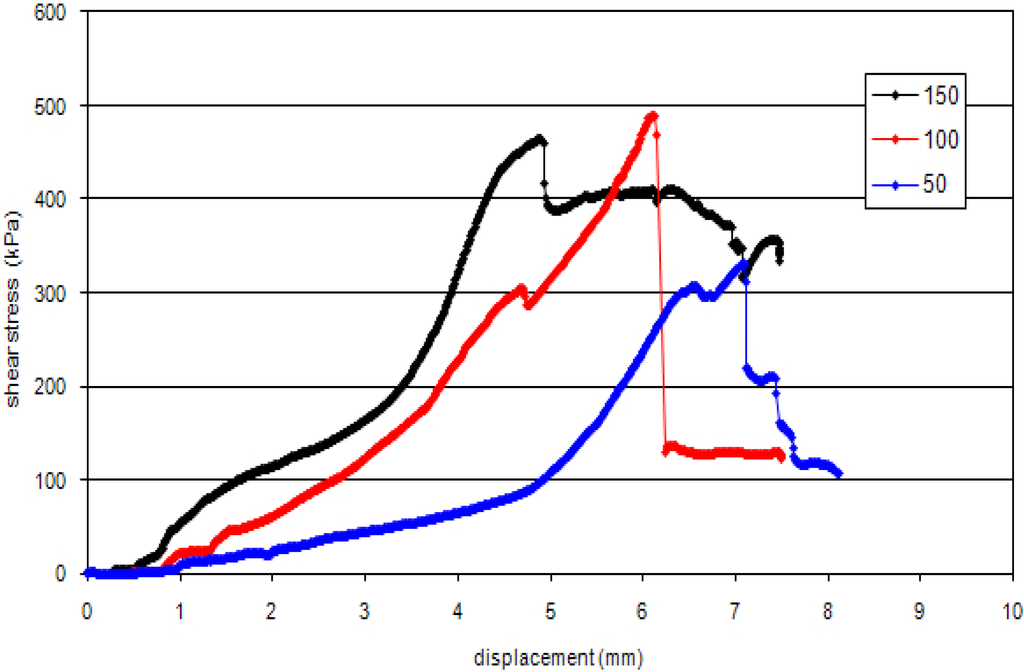
Figure 10.
Shear stress-displacement relationship for DD-samples for a constant vertical compression of 50, 100 and 150 kPa.
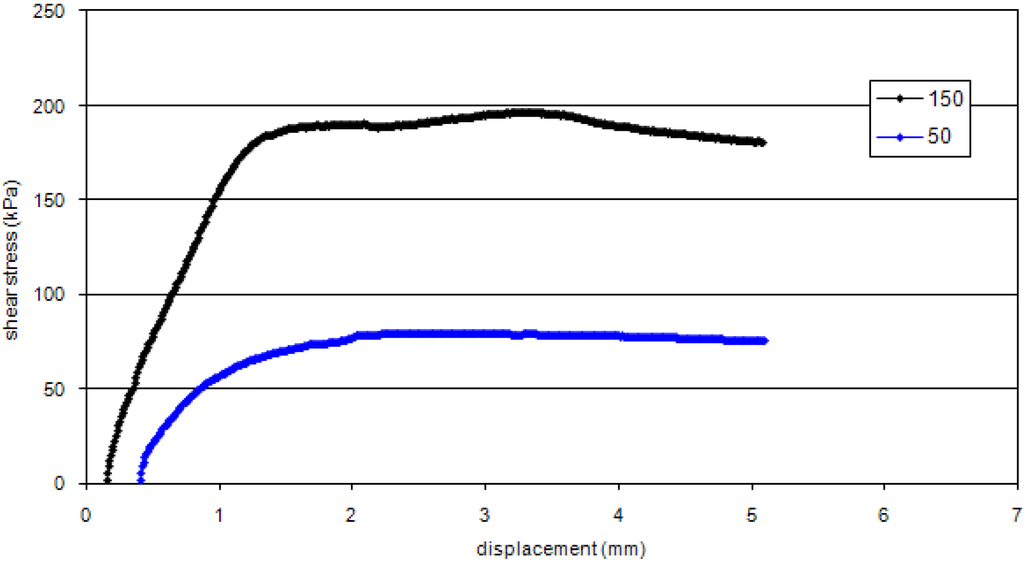
Figure 11.
Shear stress-displacement relationship for WD-samples for a constant vertical compression of 50 and 150 kPa.
WD-specimens instead showed a smoother and lower shear strength, as expected, which was, however, high (0.07−0.20 MPa) if we consider that a half-specimen is wet. In this way, it can be reasonable to suppose that these values could be increased when straw is present and above all when the moistened cob bricks will start to dry.
In this case, friction played the most important role, thus the initial shear strength seemed to be roughly proportional to the applied vertical compression stress, with a friction coefficient μ > 1. This closely corresponds to the initial shear strength that could be activated along a discontinuity between a dried existing earthen cob wall and the newly added moistened cob bricks, e.g., when a crack is repaired or an existing part of a cob earthen wall is super-elevated. In this last case, for example, if we consider a compression vertical stress of 0.05 MPa, which corresponds to about a single-storey earthen wall height of 2.5 m, along this discontinuity the initial shear strength will be about 0.07 MPa, thus a sliding collapse due to, for example, an earthquake, is avoided before it rocks as a monolithic wall [20].
3.3. Assessment of the Constructive Costs for Modern Buildings
In order to estimate the cost of the cob masonries per m3, with reference to residential buildings, we determined the cost to make a single cob brick and the cost to build a 1 m3 cob wall, considering that at least 600 cob bricks are needed to build it. If we consider to employ common workers to form hand-molded cob bricks and to use earth coming from a local quarry, the estimated cost for each cob brick (Table 4) amounts to 0.70 €, which also included the general costs and establishment’s profit. Thus, the cost to build 1 m3 of cob masonry amounts to 461.11 €/m3 (Table 5), which it very close to the cost to build 1 m3 of fired bricks masonry of about 370 €/m3.
Considering the earth masonry construction without external workers and using soil that comes from the construction site during the manufacturing process, the building costs previously estimated will be surely reduced.

Table 4.
Assessment of the total cost to make a cob brick.
| Unitary cost | Quantity | Cost | |
|---|---|---|---|
| Common worker (manufacturing process) | 16.25 €/h | 0.03 h | 0.488 € |
| Earth or coarse sand from local quarry with transport of the material (max. 1 hour) | 30.00 €/m3 | 0.002 m3 | 0.06 € |
| Straw fibers | 0.10 €/Kg | 0.02 Kg | 0.002 € |
| Cost of materials and manpower | 0.55 € | ||
| General costs (10%) | 0.055 € | ||
| Establishment’s profit (15%) | 0.09 € | ||
| Total cost for each adobe brick | 0.70 € | ||

Table 5.
Assessment of the total cost for 1 m3 of cob masonry.
| Unitary cost | Quantity | Cost | |
|---|---|---|---|
| Cost of material (1 m3) | 0.70 €/brick | 600 bricks | 420.00 € |
| Common worker | 16.25 €/h | 2 h | 32.50 € |
| General costs (10%) | 3.25 € | ||
| Establishment’s profit (15%) | 5.36 € | ||
| Cost of the manpower | 41.11 € | ||
| Total cost for 1 m3 of adobe masonry | 461.11 € | ||
4. Conclusions
Raw-earthen buildings can be considered sustainable buildings, because of their very small environmental impact, their good thermal and hygrometric performances, their sound insulation, and their potential cheapness. They also represent a cultural architectural heritage that shows the face of a local identity and that is also a testimony of an antique art of building that must be preserved.
In this way, the present research tries to regain possession of the constructional aspects of an Italian traditional cob technique and to provide some mechanical resources for its potential reuse, improving its technology, both for building new earthen masonries and making compatible restoration works on surviving architectures at affordable costs.
In this way, the following general conclusions emerge from this study on historic earth cob architectures in Macerata (Italy):
- The traditional cob manufacturing process can be improved by using a mechanical mixing machine as is commonly used for fired bricks. This could reduce times and costs.
- Cob bricks can be immediately used after their manufacturing process to build a single-storey wall even if they are still wet. This is true both for intervening on old cob architectures and for new constructions. However, some traditional rules of art of the old earthen masons should be respected. In particular:
- the wall construction should proceed layer by layer, each of no more than 0.50–0.70 m, and then it should be left to dry for some days, after that the successive level can be added;
- each cob brick should be forcefully pre-compressed between others, layer after layer, so as to have no aligned joints and to reduce deformations;
- The continuity between a dried existing earthen cob wall and the newly added moistened cob bricks, that is for example when a crack is repaired or an existing part of a cob earthen wall is super-elevated, is guaranteed by the high friction coefficient between the two different surfaces. This is generally very important when a horizontal thrust (e.g., during an earthquake) is present and has to be withstood. Even in this case, when, for example, a crack is repaired, the old rule of art saying that it is important that each new wet cob brick is forcefully pre-compressed, layer after layer, is still helpful so as to increase own weight along the discontinuity.
Besides these general rules, the results of this study have also found a suitable soil for future possible compatible restoring intervention on the investigated case study at Macerata, re-using the same ancient building technique, which is the most compatible intervention.
Acknowledgements
The investigations set out in this report received financial support from the Public Administration of Macerata (Italy), the yellow soil and the skilled mason were offered by the Smorlesi kiln in Montecassiano, Macerata (Italy). The authors extend their thanks to these bodies.
References and Notes
- Kouakou, C.H.; Morel, J.C. Strength and elasto-plastic properties of non-industrial building materials manufactured with clay as a natural binder. Appl. Clay Sci. 2009, 44, 27–34. [Google Scholar] [CrossRef]
- Bui, Q.B.; Morel, J.C.; Hans, S.; Meunier, N. Compression behaviour of non-industrial materials in civil engineering by three scale experiments: The case of rammed earth. Mater. Struct. 2009, 42, 1101–1116. [Google Scholar] [CrossRef]
- Quagliarini, E.; Lenci, S.; Iorio, M. Mechanical properties of adobe walls in a Roman Republican domus at Suasa. J. Cult. Herit. 2009, 11, 130–137. [Google Scholar] [CrossRef]
- Yetgin, Ş.; Çavdar, Ö.; Çavdar, A. The effects of the fiber contents on the mechanic properties of the adobe. Constr. Build. Mater. 2008, 22, 222–227. [Google Scholar]
- Delgado, M.C.J.; Guerrero, I.C. Earth building in Spain. Constr. Build. Mater. 2006, 20, 679–690. [Google Scholar] [CrossRef]
- Bouhicha, M.; Aouissi, F.; Kenai, S. Performance of composite soil reinforced with barley straw. Cem. Concr. Compos. 2005, 27, 617–621. [Google Scholar] [CrossRef]
- Binici, H.; Aksogan, O.; Shah, T. Investigation of fibre reinforced mud brick as a building material. Constr. Build. Mater. 2005, 19, 313–318. [Google Scholar] [CrossRef]
- L’architettura di terra nell’ambito delle attività dell’ICCROM, Roma; ICCROM: Rome, Italy, 2003. (in Italian)
- Ghavami, K.; Filho, R.D.T.; Barbosa, N.P. Behaviour of composite soil reinforced with natural fibres. Cem. Concr. Compos. 1999, 21, 39–48. [Google Scholar] [CrossRef]
- Bibliography on the Preservation Restoration and Rehabilitation of Earthen Architecture; ICCROM: Rome, Italy, 1993.
- Binici, H.; Aksogan, O.; Nuri Bodur, M.; Akca, E.; Kapur, S. Thermal isolation and mechanical properties of fibre reinforced mud bricks as wall materials. Constr. Build. Mater. 2007, 21, 901–906. [Google Scholar] [CrossRef]
- Wang, F. A study on the thermal performance of the earthen tower in summer. Build. Environ. 1992, 27, 413–421. [Google Scholar] [CrossRef]
- Goodhew, S.; Griffiths, R. Sustainable earth walls to meet the building regulations. Energ. Build. 2005, 37, 451–459. [Google Scholar] [CrossRef]
- Adam, E.A.; Jones, P.J. Thermophysical properties of stabilized soil building blocks. Build. Environ. 1995, 30, 245–253. [Google Scholar] [CrossRef]
- Venkatarama Reddy, B.V.; Prasanna Kumar, P. Embodied energy in cement stabilized rammed earth walls. Energ. Build. 2010, 42, 380–385. [Google Scholar] [CrossRef]
- Parra-Saldivar, M.L.; Batty, W. Thermal behaviour of adobe constructions. Build. Environ. 2006, 41, 1892–1904. [Google Scholar] [CrossRef]
- Martín, S.; Mazarrón, F.R.; Cañas, I. Study of thermal environment inside rural houses of Navapalos (Spain): The advantages of reuse buildings of high thermal inertia. Constr. Build. Mater. 2010, 24, 666–676. [Google Scholar] [CrossRef]
- Binici, H.; Aksogan, O.; Bakbak, D.; Kaplan, H.; Isik, B. Sound insulation of fibre reinforced mud brick walls. Constr. Build. Mater. 2009, 23, 1035–1041. [Google Scholar] [CrossRef]
- Bertagnin, M. Architetture di Terra in Italia; Edicom edizioni: Monfalcone, Italia, 1999. (in Italian) [Google Scholar]
- Giuffrè, A. A Mechanical Model for Statics and Dynamics of Historical Masonry Buildings, in Protection of the Architectural Heritage against Earthquakes; Springer-Verlag Wien: New York, NY, USA, 1996; pp. 71–152. [Google Scholar]
- ASTM D422-63 Standard Test Method for Particle-Size Analysis of Soils; ASTM international: West Conshohocken, PA, USA, 1990.
- ASTM D4318-95a Standard Test Methods for Liquid Limit, Plastic Limit, and Plasticity Index of Soils; ASTM international: West Conshohocken, PA, USA, 1995.
- ASTM D3080-04 Standard Test Method for Direct Shear Test of Soils under Consolidated Drained Conditions; ASTM international: West Conshohocken, PA, USA, 2004.
- Houben, H.; Guillaud, H. Earth Construction: A Comprehensive Guide; ITDG Publishing: Chippenham, UK, 1994. [Google Scholar]
© 2010 by the authors. Licensee MDPI, Basel, Switzerland. This article is an open access article distributed under the terms and conditions of the Creative Commons Attribution license ( http://creativecommons.org/licenses/by/3.0/).